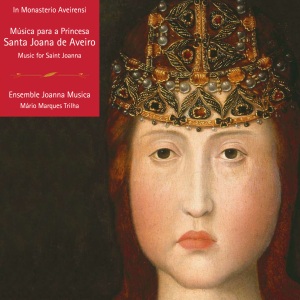NUM 1183
Title: In Monasterio Aveirensi (Musica para a Princesa Santa Joana de Aveiro)
Artists: Ensemble Joanna Musica
Composer: David Perez
The first problem that I encountered was identifying the composers of these works. In the case of the Calenda, the question of authorship was relatively easy to settle, since an attribution to José Joaquim dos Santos (1747-1801), made by the musicologist Rui Cabral, already exists in the very catalogue of the PNL. This attribution was confirmed through a study of the calligraphy and watermarks made by the eminent specialist, Dr. João Pedro d’Alvarenga. Discovering the composer of the Missa de Santa Joana, was rather more complicated. The manuscript is catalogued as “anonymous” and there is no score – the piece exists only in the form of separated parts for each of the five voices and the line for the organ (basso continuo). This transformed the task of transcription into an activity not dissimilar from solving a puzzle comprising thousands of pieces. Once again the study of the manuscript paper and its dating was used to situate the period of composition. During this phase, I enjoyed inestimable assistance from Professor J.P d’Alvarenga. As it became possible to “visualize” the composition, and its intrinsic, high quality, I began to consider that it might be a work by David Perez, who was one of the major composers working in Portugal in the second half of the 18th-century. After proposing this hypothesis to Prof. d’Alvarenga, who considered it very likely, I contacted Prof. Maurício Dottori of the Universidade Federal of Paraná, Brazil, the most important specialist on the sacred music of David Perez in the world. After detailed study, he confirmed that the Missa de Santa Joana is unquestionably the work of Perez, and added that from stylistic elements found within it, it is a composition from the last decade of the composer’s life (ca. 1770). At that time, more precisely in 1774, Aveiro was elevated to the status of a diocese, an event of great importance which would justify the commission of a Mass dedicated to St. Joana, from a composer famous throughout Europe, who was in the service of Queen D. Maria I and was held in high regard by the sovereign. This allows us to understand that music also played an extremely important role during the commemorations of the elevation to diocese that occurred as part of a larger wave of royal compensations for Aveiro.
The Missa de Santa Joana is a true compendium of compositional practice. Constituted by 18 separate numbers, it allows its composer to display various facets of his technique, including homophonic movements, fugue, solos, duos, trio and quartet; and to employ nearly the entire harmonic vocabulary from contemporary treatises of basso continuo, such as basses leaping by fourths, evoking a character more in the style of the 17th-century (in the Gratias), the very characteristic sequences of leaping fifths (in the Laudamus Te and the final group, Sanctus, Benedictus and Agnus Dei), as well as the very frequent use of ninth and eleventh chords – practically the most dissonant material possible during the period.
The uniqueness of this work, divided into 18 movements, is proof of the importance of the commission, as well as a testament of the faith of its composer, and although uncommon, it is not an isolated case in the panorama of the 18th and 19th centuries, considering the great B minor Mass by Johann Sebastian Bach and the Missa Solemnis by Ludwig van Beethoven.
The Responsório de Santa Mafalda, the Discurso de 1ºTom (Discourse on the 1st tone) by Soror da Piedade and Musica per Joanna complete the CD.
The Responsório de Santa Mafalda is a duet for sopranos and basso continuo, by an anonymous composer, probably from the second half of the 18th-century. The manuscript, from the Monastery of Arouca, is currently housed in the National Library of Lisbon, catalog no. MM 1045. Beatified one hundred years apart (St. Joana in 1693, St. Mafalda in 1793), the two princesses conferred a renown upon their respective monasteries that continues in devotions to the present day.
Descendents of the Royal Family, the two princesses, Mafalda and Joana filled the Portuguese crown with splendor, focusing national attention upon themselves and greatness upon their respective monasteries. The names Soror Maria do Patrocínio and Soror Maria Barbara are included in the manuscript, probably indicating that they were the singers responsible for the work’s premiere, which may have been composed to commemorate the feasts of their beatifications. The text comes from the Song of Songs, which may be an allusion to the brief marriage of Princess Mafalda with Henry I of Castile.
The Discourse on the 1st tone, for organ, is work in the classical style and may have been composed by Soror Piedade, which would constitute a rare case of a female composer in Portugal during the second half of the 18th-century. However, due to having encountered this name annotated in organ manuscripts by other authors, I believe that Soror Piedade was an organist, and not a composer. The manuscript of this work belongs to the private collection of Professor Gerhard Doderer.
Musica per Joanna is an homage to the Princess St. Joana, which I composed for the reopening of the Museum of Aveiro on December 18, 2008. It employs Latin and Portuguese texts taken from a compilation dating from the 1950’s by Dr. António Christo, entitled “cancioneiro de Santa Joana.”
Mário Marques Trilha
.
Sorry, the comment form is closed at this time.





